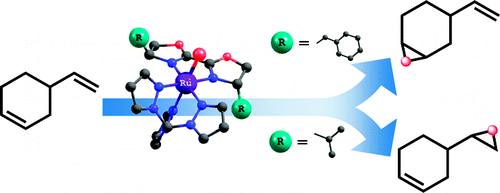The synthesis of a family of new Ru complexes containing the facial tridentate ligand with general formula [RuII(T)(D)(X)]n+ (T = trispyrazolylmethane (tpm); D = ((4S,4’S)-(-)-4,4′,5,5′-tetrahydro-4,4′-bis(1-methylethyl)-2,2′-bioxazole) (iPr-box-C) or N-(1-hydroxy-3-methylbutan-(2S)-(-)-2-yl)-(4S)-(-)-4-isopropyl-4,5-dihydrooxazole-2-carbimidate (iPr-box-O); X = Cl, H2O) has been described. All complexes have been spectroscopically characterized in solution through 1H NMR and UV-vis techniques, and the redox properties of complexes have also been studied by means of cyclic voltammetry (CV). Furthermore, the chloro complexes presented here have been characterized in the solid state through monocrystal X-ray diffraction analysis. The oxazolinic iPr-box-C ligand undergoes a Ru-assisted hydrolysis reaction generating the corresponding amidate anionic ligand iPr-box-O, that keeps coordinated to the Ru metal center and that produces a strong sigma-donation effect over it. The reactivity of the Ru-OH2 complexes described in this paper together with other similar ones, previously synthesized by us, has been tested with regard to the epoxidation of different olefins. Complexes [RuII(R-box-C)(tpm)OH2](BF4)2, R = Bz, 3’c/iPr, 3c, show high stereoselectivity in the epoxidation of cis-beta-methylstyrene, with the exclusive formation of the cis-epoxide. However, there is a significant difference in regioselectivity between the two catalysts in the epoxidation of 4-vinylcyclohexene; complex 3’c leads to the regioselective oxidation at the ring alkene position, whereas complex 3c leads to the oxidation at the terminal position. Computational calculations indicate only small energy differences between the two possible products of 4-vinylcyclohexene epoxidation, but the energy barriers for the interaction of the catalytic systems with the alkene groups of 4-vinylcyclohexene agree with the reactivity differences found for the two catalysts having isopropyl or benzyl as substituent of the oxazole ligand. Computed local Fukui functions help to explain the observed reactivity trends.
